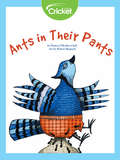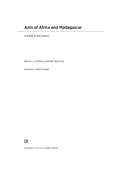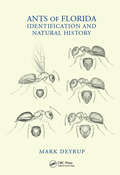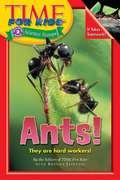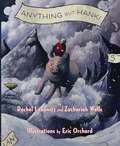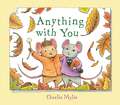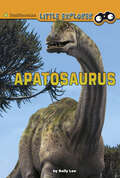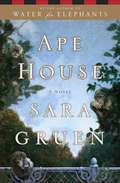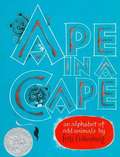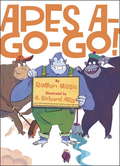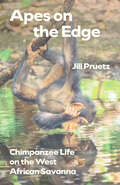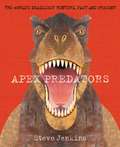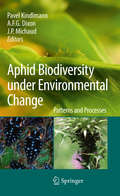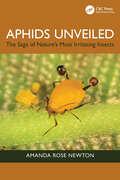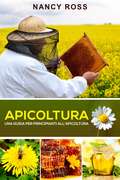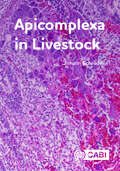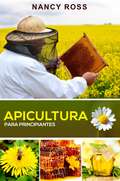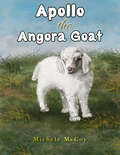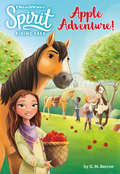- Table View
- List View
Ants in Their Pants
by Patricia Nikolina ClarkIf you accidentally sat on an anthill, and little black ants started to crawl all over you, would you stay there? Of course not!
Ants of Africa and Madagascar: A Guide to the Genera
by Barry Bolton Brian L. FisherAcross the Afrotropical and Malagasy regions, ants are one of the most conspicuous and ecologically dominant animal groups. From driver ants to weaver ants, there are over 2,000 species in Africa alone and over 600 in Madagascar. Ants of Africa and Madagascar introduces readers to the fascinating and diverse ant fauna of the Afrotropical and Malagasy regions. Featuring illustrated keys to subfamilies, separate keys to Afrotropical and Malagasy ant genera, and distribution maps, it also describes diagnostic characters, explores ant ecology and natural history, and includes a list of all currently recognized ant species in the regions. This detailed guide is an essential tool for entomologists and myrmecologists working with and learning about this diverse population of Formicidae.
Ants of Florida: Identification and Natural History
by Mark DeyrupAnts are familiar to every naturalist, ecologist, entomologist, and pest control operator. The identification of the 233 species of Florida ants is technically difficult, and information on Florida ants is dispersed among hundreds of technical journal articles. This book uses detailed and beautiful scientific drawings for convenient identification. To most Florida biologists ants are currently the most inaccessible group of conspicuous and intrusive insects. This book solves the twin problems of ant identification and the extraordinary fragmentation of natural history information about Florida ants.
Ants! (Time For Kids)
by Time for Kids EditorsAnts rule the world! These industrious insects live mostly in colonies and work together as a team. Worker ants take care of the colony and search for food. Ants eat seeds, fruit, and even other insects. Whenever ants find food, they carry it back to the colony to share. <P> Supports the Common Core State Standards
Ants, Bees, and Other Social Insects
by Kris HirschmannWorld Discovery Science Readers Ants, wasps, bees, and termites have been around a long, long time. They are here to stay. This book takes you on a journey into the fascinating world of social insects. Learn how they build their colonies, which in some species can include millions of insects. Read about insect "jobs," from queen to worker to soldier. Learn what social insects eat: paper, pollen, trees, and even each other. Discover how bees dance to show where food can be found, how ants leave scent trails, and how other ideas are communicated to colony members. Find out how social insects gang up to defend themselves from dangerous enemies. Get the buzz today!
Anxiety Disorders: Rethinking and Understanding Recent Discoveries (Advances in Experimental Medicine and Biology #1191)
by Yong-Ku KimThis book reviews all important aspects of anxiety disorders with the aim of shedding new light on these disorders through combined understanding of traditional and novel paradigms. The book is divided into five sections, the first of which reinterprets anxiety from a network science perspective, examining the altered topological properties of brain networks in anxiety disorders. The second section discusses recent advances in understanding of the neurobiology of anxiety disorders, covering, for example, gene-environmental interactions and the roles of neurotransmitter systems and the oxytocin system. A wide range of diagnostic and clinical issues in anxiety disorders are then addressed, before turning attention to contemporary treatment approaches in the context of novel bio-psychosocial-behavioral models, including bio- and neurofeedback, cognitive behavioral therapy, neurostimulation, virtual reality exposure therapy, pharmacological interventions, psychodynamic therapy, and CAM options. The final section is devoted to precision psychiatry in anxiety disorders, an increasingly important area as we move toward personalized treatment.Anxiety Disorders will be of interest for all researchers and clinicians in the field.
Anybody at Home?
by H. A. ReyThe short verses in Anybody at Home? ask children to identify various homes and the animals and objects that live there
Anything But Hank
by Zachariah Wells Eric Orchard Rachel LebowitzIn Anything But Hank! Rachel Lebowitz and Zachariah Wells combine the whimsical humour of Lewis Carroll with the adventure-narrative balladeering of Robert Service to spin an unforgettable tale of a baby -- and a pig! -- in search of a name. Their quest takes them from the city to the mountains, as they seek an audience with the Wizard and his baby-naming Mexican beaded lizard. The story, accompanied by the gorgeously lush paintings of Eric Orchard, is a delight for readers of all ages.
Anything with You: A Picture Book
by Charlie MylieWith charming, expressive characters, lush autumn landscapes, and spare text, the picture book Anything with You by author-illustrator Charlie Mylie is a sweet story about how journeys are more about who you’re with than where you’re going.A mouse and his friend are going on an adventure! What are they going to find? They’ll wander through the woods, looking everywhere and exploring everything. As they follow the trails and search together, they’ll see that anything is more fun when you’re with your best friend.Another touching, heartfelt story from Charlie Mylie, the author-illustrator of Something for You.
Ape House: A Novel
by Sara GruenGruen returns with another immensely charming, endlessly surprising, and engaging novel in which a family of apes teaches us what it means to be human. Sara Gruen's Water for Elephants has become one of the most beloved and bestselling novels of our time. Now Gruen has moved from a circus elephant to family of bonobo apes. When the apes are kidnapped from a language laboratory, their mysterious appearance on a reality TV show calls into question our assumptions about these animals who share 99.4% of our DNA. A devoted animal lover, Gruen has had a life-long fascination with human-ape discourse, and a particular interest in Bonobo apes, who share 99.4% of our DNA. She has studied linguistics and a system of lexigrams in order to communicate with apes, and is one of the few visitors who has been allowed access to the Great Ape Trust in Des Moines, Iowa, where the apes have come to love her. In bringing her experience and research to bear on this novel, she opens the animal world to us as few novelists have done. Ape House is a riveting, funny, compassionate, and, finally, deeply moving new novel that secures Sara Gruen's place as a master storyteller who allows us to see ourselves as we never have before.
Apes A-Go-Go!
by A. Richard Allen Roman MilisicWhen the mayor of a very tidy town notices a single flower out of place, Fussy Great Ape helpfully offers to fix it...but he demolishes the rest of the flowerbed in the process. He doesn't want the mayor to worry. He sounds off the ape call to action--"Bogo! Pogo! Apes-A-Go-Go!"--and Mucky Great Ape turns up to replant the flowers. Now the flowers look lovely...but now the entire town is covered in dirt! Well, it's clear what this problem calls for. More apes! These eager apes have the best intentions, but they're heaping disaster upon disaster. Can they work together to return this town to its formerly tidy glory?
Apes on the Edge: Chimpanzee Life on the West African Savanna (Animal Lives)
by Jill PruetzA moving story of survival and an eye-opening introduction to an extraordinary community of chimps and people. Fongoli chimpanzees are unique for many reasons. Their female hunters are the only apes that regularly hunt with tools, seeking out tiny bush babies with wooden spears. Unlike most other chimps, these apes fear neither water nor fire, using shallow pools to cool off in the Senegalese heat. Up to 90 percent of their home range burns annually—the result of human hunting or clearing for gold mining—and Fongoli chimpanzees have learned to predict the movement of such fires and to avoid them. The study of Fongoli chimps is also unique. While most primate research occurs in isolated reserves, Fongoli chimpanzees live alongside humans, and as primatologist and anthropologist Jill Pruetz reports, this shared habitat creates both challenges and opportunities. The issues faced by Fongoli chimpanzees—particularly food scarcity and environmental degradation—are also issues faced by their human neighbors. This connection is one reason Pruetz, who has studied Fongoli apes for over two decades, created the nonprofit Neighbor Ape in 2008 to provide for the welfare of the humans who share their landscape with apes. It is also why Pruetz decided to write this book, the first to offer readers a view of these chimps’ lives and to explain the specific conservation efforts needed to help them. Incorporating stories from Pruetz’s time in the field, including the compelling rescue of a young chimp from poachers, Apes on the Edge opens a fascinating window into primate research, conservation, and the inner workings of a very special population of our closest nonhuman relatives.
Apex Predators: The World's Deadliest Hunters, Past and Present
by Steve JenkinsWhat does it take to be the “top dog”? In his latest book, the award-winning author and illustrator Steve Jenkins introduces readers to apex predators—the animals that are at the top of their food chains and have no natural enemies. Using his signature art style, Jenkins illustrates how these animals dominate their different ecosystems using speed, strength, and even cooperation and cunning. Take a trip through history and discover apex predators both past and present, from the earliest sea creatures to the modern African lion and giant freshwater ray, which can grow to over fifteen feet.
Apex Predators: The World's Deadliest Hunters, Past and Present (Into Reading, Trade Book #2)
by Steve JenkinsNIMAC-sourced textbook
Aphid Biodiversity under Environmental Change: Patterns and Processes
by J. P. Michaud Pavel Kindlmann A.F.G. DixonThis book presents completely novel, yet unpublished findings on aphid population dynamics and ecology in the context of recent environmental changes and closely related issues. It can be used as complementary text in any course on population dynamics and ecology of crop pests at undergraduate or graduate levels. The book is intended mainly for graduate students, researchers in crop science, crop protection, agricultural advisors and managers, but it will surely attract attention of many other people interested in insect pests, their biological control and ecology.
Aphids Unveiled: The Saga of Nature's Most Irritating Insects
by Amanda Rose NewtonAphids Unveiled: The Saga of Nature's Most Irritating Insects explores the curious journey of these tiny insects from humble beginnings to becoming the most obnoxious pests for farmers and home gardeners alike. With a witty narrative style and a touch of humor, the book aims to engage readers with the quirky behaviors, social structures, and survival strategies of aphids, all while unraveling the reasons behind their impact on agriculture and horticulture.Amanda Rose Newton brings over a decade of experience in both the horticulture and pest control worlds to write for a broad audience, from gardening enthusiasts seeking effective pest management strategies to science enthusiasts interested in a lighthearted exploration of the natural world. As an entomologist and professor, her writing uniquely blends expertise with a passion for storytelling, ensuring Aphids Unveiled is not only informative but also an entertaining read.
Aphids as Crop Pests
by Richard Harrington Helmut F. EmdenAphids are among the major global pest groups, causing serious economic damage to many food and commodity crops in most parts of the world. This revision and update of the well-received first edition published ten years ago reflects the expansion of research in genomics, endosymbionts and semiochemicals, as well as the shift from control of aphids with insecticides to a more integrated approach imposed by increasing resistance in the aphids and government restrictions on pesticides. The book remains a comprehensive and up-to-date reference work on the biology of aphids, the various methods of controlling them and the progress of integrated pest management as illustrated by ten case histories. Helmut van Emden is Emeritus Professor of Horticulture at the University of Reading, UK. He has researched on aphids for over 50 years and has wide international experience, including in the tropics. Richard Harrington retired in 2015 as Head of the Rothamsted Insect Survey, with which he worked for 36 years on aphid monitoring and forecasting. He led the EU project "EXAMINE" (Exploitation of Aphid Monitoring In Europe) which brought together colleagues involved in aphid monitoring throughout Europe and beyond.
Apicoltura: Una guida per principianti all'apicoltura
by Stefania Pezzato Nancy RossSCOPRITE COME INIZIARE FACILMENTE A PRATICARE L’AGRICOLTURA! Sia che vogliate produrre miele in casa, si che vogliate migliorare la produzione del vostro orto e giardino, o per puro divertimento questo libro vi può aiutare. Ecco un assaggio di quello che imparerete... Quante arnie dovrei avere? Dove trovo le mie api? Scegliere i prodotti giusti Assemblare l’arnia Come raccogliere il miele Problemi comuni che potreste incontrare con l’apicoltura Trucchi per avere successo nel mondo dell’apicoltura E molto, molto altro!
Apicomplexa in Livestock
by Johann SchröderThe Apicomplexa is a globally prevalent group of parasitic protozoa that cause disease, from malaria in humans to livestock diseases such as coccidiosis, babesiosis (Red Water, Tick Fever) and East Coast Fever. With significant economic impacts, a number of Apicomplexa are also zoonotic, leading to grave potential public health consequences. Infection prevention efforts by immunisation or management of arthropod vector infestation have not been universally successful, and can have knock-on effects such as pollution of the environment and human food chain, and development of insecticidal or acaricidal resistance. This book highlights the similarities and differences between the various Apicomplexa infections, identifying those of greatest significance and suggesting sustainable approaches to better manage their impact on livestock productivity. The book: Reviews Australian livestock as a case study, but highlights global applications, biosecurity concerns and lessons learned; Covers Apicomplexa-caused disease across cattle, pigs, poultry and sheep; Considers human health and environmental impacts, and how sustainable management methods can better outcomes for all. Suitable for researchers and students of veterinary parasitology and related disciplines, this book is a valuable resource covering this important set of parasites.
Apicultura para principiantes
by Nancy RossLa apicultura es un pasatiempo importante no solo por la deliciosa miel que obtienes y puedes aprovechar para tu consumo o para venderla, también porque ayuda a proteger al medio ambiente. Muchas plantas dependen de las abejas para abastecerse de nutrientes y para mantenerse sanas. Mientras nosotros disfrutamos la dulce miel, las plantas y flores a nuestro alrededor disfrutan del arduo trabajo de las abejas. Si estás interesado en adentrarte en la apicultura, esta guía te brindará toda la información que necesitas para empezar. Hablaremos sobre los principios básicos de la apicultura, cómo elegir los suministros que necesitarás y los puntos básicos para empezar, por ejemplo: dónde colocar tu colmena, algunos tips para recolectar la miel al final de la temporada y algunos de los problemas a los que se enfrenta cualquier dueño de un apiario. Todo esto es muy valioso para el apicultor novato que desea asegurarse de que su colmena y sus abejas permanezcan lo más saludables posible. La apicultura no es un pasatiempo difícil de aprender. De hecho, en cuanto tengas todo el equipo listo y hayas introducido a tus abejas, podrás relajarte y dejarlas hacer su trabajo hasta que la miel esté lista. Así te estés planteando la posibilidad de iniciar con la apicultura o si tienes todo listo para empezar, este es sin duda el mejor pasatiempo para ti. Asegúrate de leer la guía completa y aprender todo lo que necesitas para iniciar.
Apollo the Angora Goat
by Michele McCoyApollo the Angora Goat is a heartwarming children&’s book that tells the story of Apollo, an Angora goat born and raised on a lively farm in California. Through Apollo&’s eyes, young readers will discover the joys of farm life, the beauty of friendships, and the adventures that come with growing up alongside a diverse group of animal friends. As Apollo and his companions play and explore their world, they learn valuable lessons about friendship and life. This charming first book in a series invites children to join Apollo on his delightful adventures, promising a journey filled with fun and learning.
Apple Adventure! (Spirit Riding Free)
by G. M. BerrowJoin Miradero's favorite PALs as they explore the frontier and beyond in the first installment of an adventurous new original fiction chapter book series, inspired by DreamWorks Spirit Riding Free.Lucky, Pru, and Abigial couldn't be more excited! Each Frontier Fillies herd is holding a fund-raiser for a very special Jamboree, and whichever team raises the most money will win the Golden Horseshoe! The PALs are sure the trophy will be theirs after they discover an orchard full of delicious apples plus a new friend named Vida! In exchange for her family's harvest to use in a bake sale, Vida gets riding lessons from Lucky and her friends. But when the PALs return to Miradero, it turns out Vida isn't the new friend they thought....With Maricela suddenly acting strangely and a time crunch on their hands, will the PALs be able to bake their way to victory?DreamWorks Spirit Riding Free © 2019 DreamWorks Animation LLC. All Rights Reserved.
Apple Countdown
by Joan Holub Jan SmithField trip today--to the apple farm! Count 20 name tags, 19 kids on the bus, 18 miles to the farm. There are 14 cows and 13 ducks (10 white and 3 black), and 12 rows of apple trees. Count the apples in your sack, count 3 pies to eat (divided into 20 pieces), and all too soon it's 2 o'clock, time to go! But wait--Lee has a number-1 surprise. Joan Holub's creative countdown, from 20 to 1, includes grouping and simple addition. Her multicultural students enjoy all that the apple farm has to offer, from counting the cows and ducks to picking different varieties of apples. The endpapers of this cheerful book are filled with apple facts.
